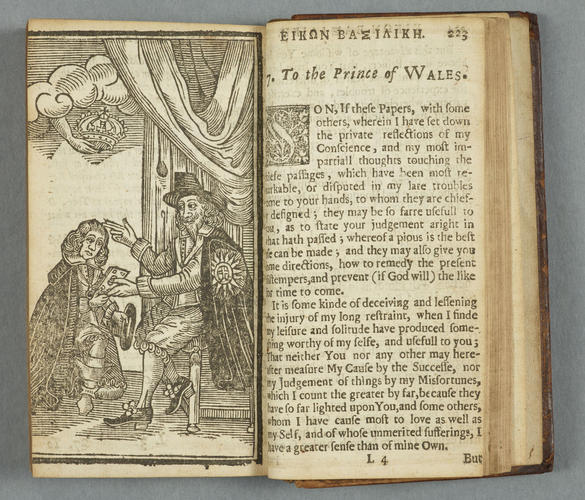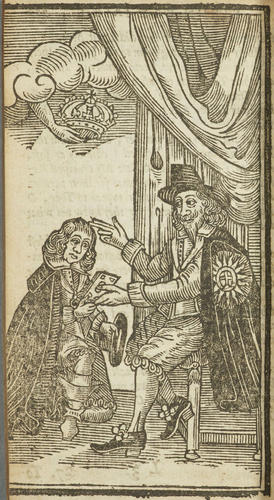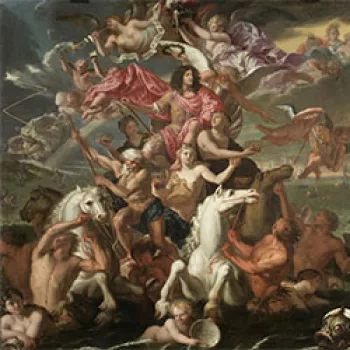Eikon Basilike: the portraicture of His Sacred Majestie in his solitudes and sufferings. 1649
Later binding in brown calf | 12.2 x 7.0 x 1.7 cm (book measurement (conservation)) | RCIN 1098507

Attributed to Charles I, King of Great Britain (1600-49)
Eikon Basilike: the portraicture of His Sacred Majestie in his solitudes and sufferings 1649


-
While Charles I, the monarch executed by parliament in 1648/9, has traditionally been identified as the author of Eikon Basilike, this has been disputed since John Gauden, Bishop of Worcester, emerged as a probable ghostwriter in the 1690s. It is now thought to have been a collaboration between Gauden and the king.
The book reviews the course of the civil wars from the calling of the Long Parliament in 1640 to Charles's imprisonment at Carisbrooke Castle in 1647, and defends the king's policies. As well as being a political memoir it also uses the language of spiritual autobiography, presenting Charles as the defender of both Church and State.
'Eikon Basilike' means 'portrait of the king'. The portrayal of Charles in the text as a moderate, peace-loving ruler transformed opinion of his execution so that it came to be viewed by many as an act of martyrdom. The frontispiece of the book, designed by William Marshall, helped establish this image of Charles as a saint and martyr: the king grasps a crown of thorns whilst his royal crown lies at his feet, discarded in favour of the heavenly crown of glory upon which he fixes his gaze.
Despite the government's attempts to suppress the words of the king they had just executed, Eikon Basilike became an immediate best-seller, and was to become one of the most influential books of the seventeenth century. The first edition was in print on the day of Charles's execution, and in 1649 alone thirty-five editions were published in England, with a further twenty-five issued elsewhere in Europe. Its popularity and its scriptural qualities, along with its anticipation of the return of the Stuart monarchy in Charles's advice to his son, helped to bring about support for the Restoration of Charles II in 1660.
The penultimate chapter of Eikon Basilike is addressed from Charles I to the Prince of Wales, the future Charles II. He is exhorted to consider the welfare of his subjects; to be steadfast in his religion; not to dislike Parliament, despite its current 'insolencies'; and to defer to his mother, Henrietta Maria. The chapter concludes: 'if God will have disloyalty perfected by My destruction; let My memory ever, with My name, live in you…. Farewell, till We meet, if not on Earth, yet in Heaven.' Instead of the more common portrait of Charles II as Prince of Wales which usually faces this chapter opening, this rare edition of Eikon Basilike contains a woodcut of a seated Charles I, blessing a kneeling Prince of Wales and passing him a copy of his book. This presents the Prince as the chosen successor to the executed King, and highlights the importance of Eikon Basilike and its imagery in heralding the Restoration.Provenance
Probably acquired for the Royal Library in the 20th century
-
Creator(s)
Attributed to (author)(illustrator) -
Medium and techniques
Later binding in brown calf
Measurements
12.2 x 7.0 x 1.7 cm (book measurement (conservation))
12.5 x 2.0 cm (book measurement (inventory))
Other number(s)
Madan : Madan, F.F., 1950. A New bibliography of the Eikon Basilike of King Charles the First …, London – Madan 29, 1st issueESTC : English Short Title Catalogue Citation Number – ESTC R176613








